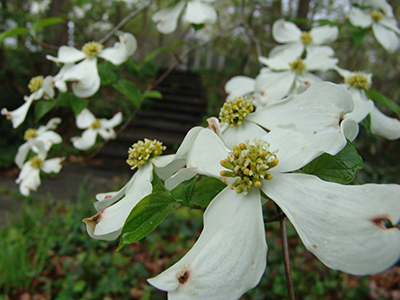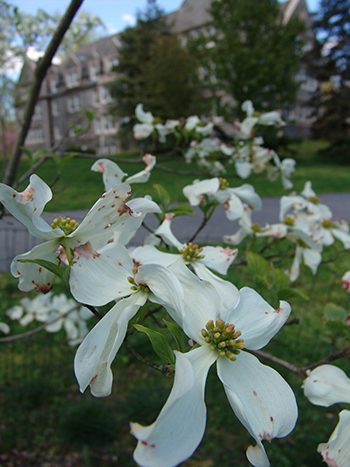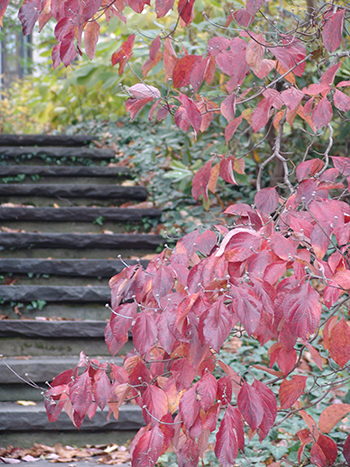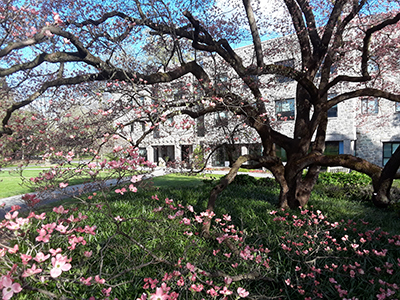
Plant of the Month: Cornus florida

A native plant brightening up the Arboretum and much of the local landscape is the ever endearing flowering dogwood, Cornus florida. In April and May this small native tree puts on a flowering show throughout much of the Eastern United States.

Interestingly enough, the flowers of the flowering dogwood are quite inconspicuous, tiny yellow-green knobs clustered tightly together between four, large, petal-like bracts. photo credit: R. Robert
Interestingly enough, the flowers of the flowering dogwood are quite inconspicuous, tiny yellow-green knobs clustered tightly together between four, large, petal-like bracts. Flower bracts are available in shades of pink or red in cultivation, though the species color is typically white. These showy floral appendages are undoubtedly what make this tree so treasured, but C. florida has many more landscape attributes.

In autumn, foliage turns hues of deep red and purple, creating another seasonal spectacle. photo credit: R. Robert
Flowers of C. florida transform into ravishing red fruits in late summer, a favorite of wildlife, though inedible for humans. In autumn, foliage turns hues of deep red and purple, creating another seasonal spectacle. With age C. florida develops horizontal, tier-like branching and a flattened top, adding unique character and further improving the presentation of this tree in flower. Older trees also develop alligator hide-like bark, which paired with an elegant silhouette make this tree a stand out in the winter too.

C. florida var. rubra, with reddish-pink bracts that open flat. photo credit: R. Payne-Meyer
Naturally occurring from Maine to Florida, C. florida is typically found as an understory plant, and along forest margins. C. florida prefers rich, moist, well drained soil, and part-shade, though plants can tolerate full sun, and a range of soil conditions. With great ornamental and ecological value, as well as broad adaptability, this tree is worthy of consideration in gardens in the city, suburbs, and countryside. The versatile nature of C. florida allows use as a specimen, or small grouping in lawns, around homes and patios, in meadows or woodland gardens, grown in sun or shade.

C. florida ‘Pluribracteata’, whose somewhat cupped double bracts, have a tinge of red at the base. photo credit: R. Payne-Meyer
In the words of woody plant authority Michael Dirr, C. florida is “the aristocrat of small flowering trees,” “the envy of every landscape plant,” and “a superb specimen that will never go out of style.” Two of my favorite C. florida specimens at the Scott Arboretum grace the lawn outside the Martin Biological Laboratory: C. florida var. rubra, with reddish-pink bracts that open flat, and C. florida ‘Pluribracteata’, whose somewhat cupped double bracts, have a tinge of red at the base. Both of these plants have exquisite form and flowers (bracts) – aristocratic indeed. Plan a trip to the Scott Arboretum today and you can enjoy all these lovely flowers and more firsthand!





Julia Welbon
Posted at 14:11h, 08 MayI’m delighted to see this article which serves as a memorial tribute to the very mature Dogwood on our Wallingford front lawn that was blown over in the winds of April 30th night. What a shock on Friday morning, tempered with gratitude that it landed away from our house and short of the street! Our c.florida was approaching the end of its very long run, but was in bountiful full bloom. It was already fully grown when we first came to our home 37 years ago and we worried when there were stories that all Dogwoods were doomed at least 20 years ago. Both of ours make it through that challenge. Your article has helped us answer the question of what should replace our tree: another c.florida!
Becky Robert
Posted at 14:15h, 08 MayDear Julia, I am so glad this article was inspirational. I, personally, inherited a mature dogwood and have planted two more on my property. Such a wonderful native tree!
Sincerely,
Becky Robert
Scott Arboretum